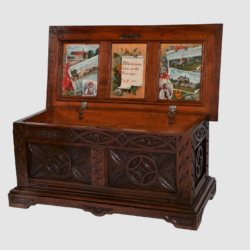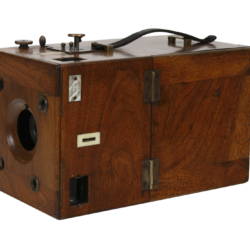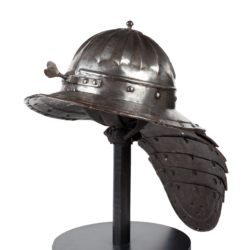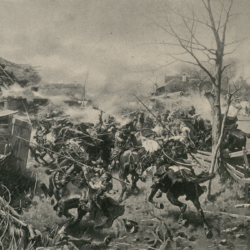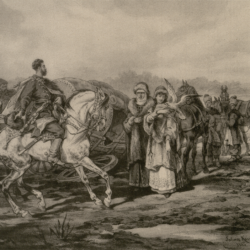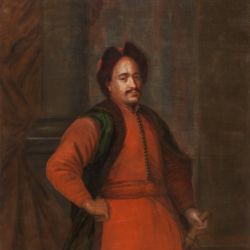
Sienkiewicz: still valid
In just a few days, Sienkiewicz’s Knights of the Teutonic Order shall conquer the panoramic screens of Polish towns. In a grand, wide-screen, colorful adaptation of the historical novel – divided into two parts, and directed by Aleksander Ford – we are going to see our favorite fictional characters: brave Zbyszko (Mieczysław Kalenik), misfortunate Danusia (Grażyna Staniszewska) accompanied by the tragic character of her father, Jurand ze Spychowa (Andrzej Szalawski), rowdy Jagienka (Urszula Modrzyńska) and many others.[1]
The Knights of the Teutonic Order premiere was planned for September 2, 1960: the very beginning of the school year, which also coincided with the anniversary of the onset of WWII. The film’s premiere – in which Władysław Gomułka, Secretary General of the Polish United Workers’ Party, participated – took place in summer, in the Polonia cinema in Olsztyn. The event was held at the time of the celebrations of the 550th anniversary of the Battle of Grunwald, which were taking place on July 15 at the Tomb of the Unknown Soldier in Warsaw and on July 16 and 17 in Grunwald.
A short note about the upcoming premiere reveals a lot about the reception of Sienkiewicz’s fiction and the way in which the state’s propaganda took advantage of it. Firstly, the film was introduced as a great spectacle – long and consisting of two parts, colored (which was still a novelty, and in the case of Ford’s film grew out of an economic decision made by the main authorities[2]), panoramic (and thus promising a feast for thrill-seekers). This modern spectacle was, however, available only for the chosen ones: the audiences of the largest cities in Poland. Secondly, Sienkiewicz’s work was known to all spectators – including the ones doomed for lower quality screenings. The protagonists of Sienkiewicz’s novels would “come alive” in front of the audiences – but they would lack the complexity of a literary presentation, being reduced to a distinctive personality trait fitting the action frame of brave Zbyszko trying to save the unlucky child of a tragic father in order to finally engage in a relationship with Jagienka. Within the film, this closed narrative scheme gained a clear visual form, co-created by the cinematographer, scenographer, costume designer, and – predominantly – by the actor.
The product – costly, and proving high economic growth – was supposed to be modern and up-to-date, which is proven by the title of the note: “The Validity of the Knights of the Teutonic Order”. Just after the premiere, “Express Poznański” [The Poznań Express] stated: “a splendid film” in which “the story of the greatest battle of the Middle Ages entices us to evaluate multiple contemporary issues” [trans. K.F]. This statement itself can be quite funny, but it points to the third important aspect of the reception of the film adaptations. Movies based on Sienkiewicz’s fiction were huge productions endowed with the emotional power of famous narratives, hence they incited questions about the films’ compatibility with the literary original, or even about their convergence with the images present in the minds of the recipients. There were doubts (resembling of Stanisław Brzozowski or Professor Pimko) concerning the validity of Sienkiewicz’s ideas. Every time huge efforts were taken in order to produce another spectacular adaptation of Sienkiewicz’s work, a single issue reappeared – is it still important today?
Krzysztof Teodor Toeplitz disagreed with all attempts at making Kmicic and other characters of The Deluge more contemporary, and emphasized the cinematic qualities of the adaptation[3]. Anna Tatarkiewicz scathed the return to Sienkiewicz and his “conservatively-bigoted” ideas, ironically asking “what can Poles actually learn from them”, and “of what use are they for a society of culturally developing peasants and laborers” [trans. K.F][4]. Tatarkiewicz quoted a reader, who posited that such films “cannot help in the development of young Poles’ characters”, while “the alleged arguments about Trilogy strengthening the feeling of connection with one’s own nation are today, in 1974, largely detrimental” [trans. K.F.]. Such opinions of critics and viewers alike were, however, rarely encountered. The authorities believed that regardless of Sienkiewicz’s conservatism, his work can help achieve some of their current aims.
A film adaptation of any literary work, understood – as Alicja Helman puts it – as the “proof of reading” [trans. K.F][5], inevitably becomes the authentication of particular social opinions. This is because the text is read not only individually by the director or the screenwriter, but the reading of a text in the collective process of a film production becomes subject to various, already mentioned, mediations, and also has to provide for the power of official censorship as well as for the quasi-censorship of the spectators, which always best know the looks and the behavior of their favorite protagonist. The adaptation discloses which elements of the heritage of a widely read author are interesting for their cinematographic interpretations. The created images are only successful when they cater to the needs of everyone.
Przypisy
- Cz. Michalski, “Aktualność Krzyżaków”. Imponujące dzieło naszej kinematografii [The Validity of Knights of the Teutonic Order. An Impressive Work of Our Cinematography], in “Głos Wielkopolski” [The Voice of Greater Poland”, 30.08.1960. A note sent by the Polish Press Agency, sometimes in a slightly different version, was also printed in other daily papers published by the Workers’ Publishing Cooperative “Prasa”: “Dziennik Bałtycki” [The Baltic Daily], 30.08.1960; “Dziennik Wieczorny” [The Evening Daily] (Bydgoszcz), 30.08.1960; “Przyjaźń” [The Friendship], 17.07.1960 (together with a gallery of colored photographs taken at the film set); trans. K.F.
- The first Polish movie in color – Leonard Buczkowski’s Przygoda na Mariensztacie [An Adventure on Mariensztat] – was produced in 1954, and the post-production took place in Germany.
- K.T. Toeplitz, “Potop” czyli o rzetelności [The Deluge or About Reliability] in “Miesięcznik Literacki” [The Literary Monthly] 1974, issue 11.
- A. Tatarkiewicz, Nie dajmy się uPOTOPić [Deluge or Delusion?] in “Tygodnik Powszechny” 1974, issue 39; Czy “Potop” krzepi? [Does The Deluge Cheer Us Up?] in “Tygodnik Kulturalny” [The Cultural Weekly] 1974, issue 38.
- See A. Helman, Dziesięć tez na temat filmowej adaptacji literatury [Ten Theses about Cinematic Adaptations of Literature] in Wokół problemów adaptacji filmowej [On the Problems of Film Adaptations], edited by E. Nurczyńska-Fidelska and Zbigniew Batko, Łódź 1997, p. 12.

